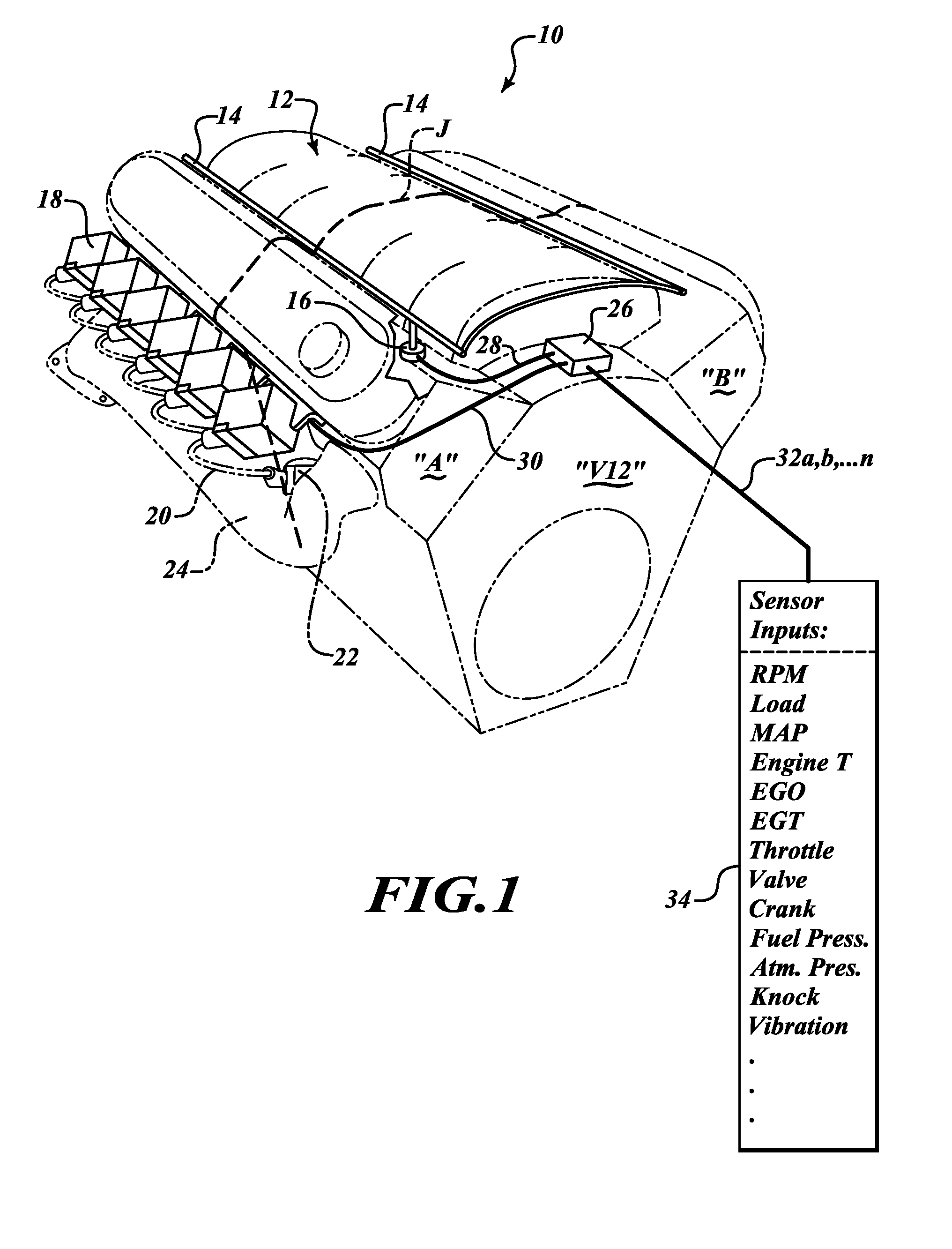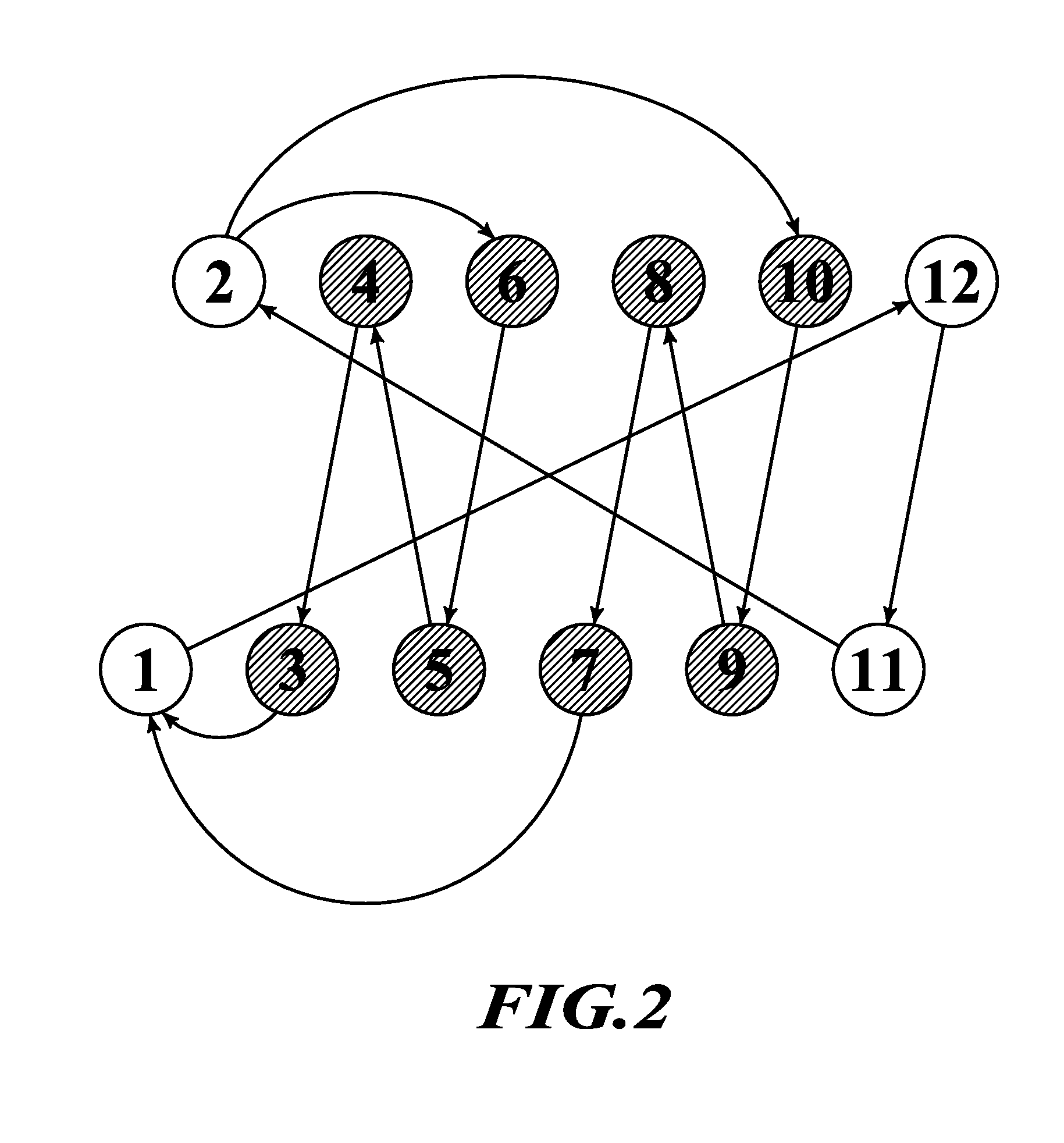Even fire 90°V12 IC engines, fueling and firing sequence controllers, and methods of operation by PS/P technology and IFR compensation by fuel feed control
a 90°v12 ic engine and controller technology, applied in the direction of electrical control, process and machine control, instruments, etc., can solve the problems of premature ignition knock, reduced engine efficiency, and inability to achieve the maximum theoretical power output, so as to achieve easy determination, reduce emissions generation, and increase power output
- Summary
- Abstract
- Description
- Claims
- Application Information
AI Technical Summary
Benefits of technology
Problems solved by technology
Method used
Image
Examples
example 1
Construction and Operation of an Inventive 90°V12 Engine
[0089]FIG. 1 shows an example of the inventive 90°V12 engine 10, constructed by modifying a pair of identical GM short block aluminum 90°V8 engine blocks, by milling off the rear two cylinders of block #1 and the front two cylinders of block #2. The two blocks were carefully aligned, heli-arc welded together and machine finished to form one, integrated 90°V12 engine block, identified as “V12” in the figure. As shown in FIG. 1, the aft end of the engine 10 is in the foreground; that is, the engine is being viewed as if from the driver's side. The left cylinder head bank, A, housing the odd-numbered cylinders and the right bank, B, the even-numbered cylinders.
[0090]A new crankshaft of high strength steel was machined with the appropriate angle orientation for the 12 piston connecting rod journals and fitted in the V12 block, borne by a total of 7 main journal bearings. That is, in a V8 there are 5 main bearings, of which one is a...
example 2
IFR Compensation System
[0103]The engine of Example 1, FIGS. 1-3, exhibited transitory vibration in the approximately 1600-1800 RPM range (as determined by tachometer reading) due to imbalance. That is the IFR range for this particular engine; one skilled in this art will understand that each different engine configuration constructed in accord with the principles of the invention as a 90°V12 can be dynamometer tested to determine its unique IFR range and other characteristics.
[0104]To counteract the vibration, injector leads for cylinders 4, 6 on the right bank and 3, 5 on the left bank were removed. That is a simple, and direct, hardwire simulation of a production engine, resulting in dead lean fueling of those cylinders. In effect, the PCM “thinks” the engine is a V8, when in fact it is a V12. This means that in its simplest implementation, the inventive 90°V12 engine can use an off-the-shelf V8 PCM EFI and DIS controller systems, including sensors and outputs, with only selected ...
example 3
PCM Controller Maps
[0111]The PS / P programming is straight-forward; the PCM controller EEPROM is configured to both inject fuel by signals to the injector solenoids and signals to the coils via the respective trigger wiring to simultaneously fuel and, at the appropriate time relative thereto (typically microseconds or milliseconds after initiation of injection), fire four pairs of cylinders: 6 / 10; 5 / 9; 4 / 8; and 3 / 7; in the sequence that a V8 would normally fire. The programming can be individual data entry into existing maps, or downloading a complete set of new maps for a particular engine. Tables 3 and 4 below are working examples of fueling and ignition maps that are programmed into the PCM controller in accordance with the inventive PS / P technology to implement it in the exemplary inventive 90°V12 engine having EFI and DIS systems controlled by the PCM microprocessor:
[0112]
TABLE 3PCM Controller Fueling Map, 92 Octane Pump GasolineOpen Loop F / A Ratio (g / g) vs Coolant Temp vs MAPMa...
PUM
 Login to View More
Login to View More Abstract
Description
Claims
Application Information
 Login to View More
Login to View More - R&D
- Intellectual Property
- Life Sciences
- Materials
- Tech Scout
- Unparalleled Data Quality
- Higher Quality Content
- 60% Fewer Hallucinations
Browse by: Latest US Patents, China's latest patents, Technical Efficacy Thesaurus, Application Domain, Technology Topic, Popular Technical Reports.
© 2025 PatSnap. All rights reserved.Legal|Privacy policy|Modern Slavery Act Transparency Statement|Sitemap|About US| Contact US: help@patsnap.com



